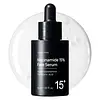What's inside
What's inside
 Key Ingredients
Key Ingredients

 Benefits
Benefits

 Ingredients Side-by-side
Ingredients Side-by-side

Oryza Sativa Bran Water
MaskingGlycerin
HumectantButylene Glycol
Humectant1,2-Hexanediol
Skin ConditioningAlpha-Arbutin
AntioxidantMethylpropanediol
SolventNiacinamide
SmoothingMethyl Gluceth-20
HumectantWater
Skin ConditioningPanthenol
Skin ConditioningTrehalose
HumectantGlyceryl Glucoside
HumectantHydroxyethyl Acrylate/Sodium Acryloyldimethyl Taurate Copolymer
Emulsion StabilisingHydroxyethylcellulose
Emulsion StabilisingAcrylates/C10-30 Alkyl Acrylate Crosspolymer
Emulsion StabilisingAllantoin
Skin ConditioningEthylhexylglycerin
Skin ConditioningXanthan Gum
EmulsifyingArginine
MaskingDisodium EDTA
Polysorbate 60
EmulsifyingSorbitan Isostearate
EmulsifyingMomordica Charantia Fruit Extract
Skin ConditioningLactobacillus Ferment
Skin ConditioningAloe Barbadensis Leaf Extract
EmollientAngelica Gigas Root Extract
Skin ConditioningAstragalus Membranaceus Root Extract
EmollientAvena Sativa Kernel Extract
AbrasiveBetula Alba Bark Extract
MaskingCamellia Sinensis Leaf Extract
AntimicrobialCnidium Officinale Root Extract
Skin ConditioningCoix Lacryma-Jobi Ma-Yuen Seed Extract
Skin ConditioningCucumis Sativus Fruit Extract
EmollientDioscorea Japonica Root Extract
Skin ConditioningFicus Carica Fruit Extract
HumectantGinkgo Biloba Leaf Extract
Skin ConditioningGlycine Soja Seed Extract
Skin ConditioningGlycyrrhiza Glabra Root Extract
BleachingHoney Extract
HumectantLycium Chinense Fruit Extract
AntioxidantMangifera Indica Fruit Extract
Skin ConditioningMorus Alba Fruit Extract
AntioxidantOryza Sativa Extract
AbsorbentPaeonia Lactiflora Root Extract
Skin ConditioningPanax Ginseng Root Extract
EmollientPhaseolus Radiatus Seed Extract
Skin ConditioningPhellinus Linteus Extract
Skin ConditioningPortulaca Oleracea Extract
Skin ConditioningPrunus Mume Fruit Extract
HumectantPueraria Lobata Root Extract
HumectantPunica Granatum Fruit Extract
AntioxidantSolanum Lycopersicum Fruit Extract
AntioxidantSophora Angustifolia Root Extract
Skin ConditioningTricholoma Matsutake Extract
Skin ConditioningDisodium Phosphate
BufferingAngelica Gigas Extract
Skin ConditioningSodium Phosphate
BufferingOryza Sativa Bran Water, Glycerin, Butylene Glycol, 1,2-Hexanediol, Alpha-Arbutin, Methylpropanediol, Niacinamide, Methyl Gluceth-20, Water, Panthenol, Trehalose, Glyceryl Glucoside, Hydroxyethyl Acrylate/Sodium Acryloyldimethyl Taurate Copolymer, Hydroxyethylcellulose, Acrylates/C10-30 Alkyl Acrylate Crosspolymer, Allantoin, Ethylhexylglycerin, Xanthan Gum, Arginine, Disodium EDTA, Polysorbate 60, Sorbitan Isostearate, Momordica Charantia Fruit Extract, Lactobacillus Ferment, Aloe Barbadensis Leaf Extract, Angelica Gigas Root Extract, Astragalus Membranaceus Root Extract, Avena Sativa Kernel Extract, Betula Alba Bark Extract, Camellia Sinensis Leaf Extract, Cnidium Officinale Root Extract, Coix Lacryma-Jobi Ma-Yuen Seed Extract, Cucumis Sativus Fruit Extract, Dioscorea Japonica Root Extract, Ficus Carica Fruit Extract, Ginkgo Biloba Leaf Extract, Glycine Soja Seed Extract, Glycyrrhiza Glabra Root Extract, Honey Extract, Lycium Chinense Fruit Extract, Mangifera Indica Fruit Extract, Morus Alba Fruit Extract, Oryza Sativa Extract, Paeonia Lactiflora Root Extract, Panax Ginseng Root Extract, Phaseolus Radiatus Seed Extract, Phellinus Linteus Extract, Portulaca Oleracea Extract, Prunus Mume Fruit Extract, Pueraria Lobata Root Extract, Punica Granatum Fruit Extract, Solanum Lycopersicum Fruit Extract, Sophora Angustifolia Root Extract, Tricholoma Matsutake Extract, Disodium Phosphate, Angelica Gigas Extract, Sodium Phosphate
 Reviews
Reviews

Ingredients Explained
These ingredients are found in both products.
Ingredients higher up in an ingredient list are typically present in a larger amount.
1,2-Hexanediol is a synthetic liquid and another multi-functional powerhouse.
It is a:
- Humectant, drawing moisture into the skin
- Emollient, helping to soften skin
- Solvent, dispersing and stabilizing formulas
- Preservative booster, enhancing the antimicrobial activity of other preservatives
Allantoin is a soothing ingredient known for its protective and moisturizingg properties. Because of this, it is often added to products with strong active ingredients.
Studies show higher concentrations of this ingredient can promote wound healing.
Though it can be derived from the comfrey plant, allantoin is produced synthetically for cosmetic products to ensure purity.
Learn more about AllantoinNiacinamide is a multitasking form of vitamin B3 that strengthens the skin barrier, reduces pores and dark spots, regulates oil, and improves signs of aging.
And the best part? It's gentle and well-tolerated by most skin types, including sensitive and reactive skin.
You might have heard of "niacin flush", or the reddening of skin that causes itchiness. Niacinamide has not been found to cause this.
In very rare cases, some individuals may not be able to tolerate niacinamide at all or experience an allergic reaction to it.
If you are experiencing flaking, irritation, and dryness with this ingredient, be sure to double check all your products as this ingredient can be found in all categories of skincare.
When incorporating niacinamide into your routine, look out for concentration amounts. Typically, 5% niacinamide provides benefits such as fading dark spots. However, if you have sensitive skin, it is better to begin with a smaller concentration.
When you apply niacinamide to your skin, your body converts it into nicotinamide adenine dinucleotide (NAD). NAD is an essential coenzyme that is already found in your cells as "fuel" and powers countless biological processes.
In your skin, NAD helps repair cell damage, produce new healthy cells, support collagen production, strengthen the skin barrier, and fight environmental stressors (like UV and pollution).
Our natural NAD levels start to decline with age, leading to slower skin repair, visible aging, and a weaker skin barrier. By providing your skin niacinamide, you're recharging your skin's NAD levels. This leads to stronger, healthier, and younger looking skin.
Another name for vitamin B3 is nicotinamide. This vitamin is water-soluble and our bodies don't store it. We obtain Vitamin B3 from either food or skincare. Meat, fish, wheat, yeast, and leafy greens contain vitamin B3.
The type of niacinamide used in skincare is synthetically created.
Learn more about NiacinamideWater. It's the most common cosmetic ingredient of all. You'll usually see it at the top of ingredient lists, meaning that it makes up the largest part of the product.
So why is it so popular? Water most often acts as a solvent - this means that it helps dissolve other ingredients into the formulation.
You'll also recognize water as that liquid we all need to stay alive. If you see this, drink a glass of water. Stay hydrated!
Learn more about WaterXanthan gum is used as a stabilizer and thickener within cosmetic products. It helps give products a sticky, thick feeling - preventing them from being too runny.
On the technical side of things, xanthan gum is a polysaccharide - a combination consisting of multiple sugar molecules bonded together.
Xanthan gum is a pretty common and great ingredient. It is a natural, non-toxic, non-irritating ingredient that is also commonly used in food products.
Learn more about Xanthan Gum